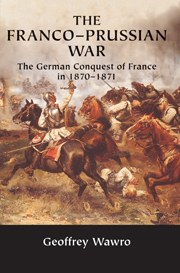Book contents
- Frontmatter
- Contents
- List of Abbreviations
- List of Illustrations
- Acknowledgments
- Introduction
- 1 Causes of the Franco-Prussian War
- 2 The Armies in 1870
- 3 Mobilization for War
- 4 Wissembourg and Spicheren
- 5 Froeschwiller
- 6 Mars-la-Tour
- 7 Gravelotte
- 8 The Road to Sedan
- 9 Sedan
- 10 France on the Brink
- 11 France Falls
- 12 The Peace
- Bibliography
- Index
1 - Causes of the Franco-Prussian War
Published online by Cambridge University Press: 20 July 2009
- Frontmatter
- Contents
- List of Abbreviations
- List of Illustrations
- Acknowledgments
- Introduction
- 1 Causes of the Franco-Prussian War
- 2 The Armies in 1870
- 3 Mobilization for War
- 4 Wissembourg and Spicheren
- 5 Froeschwiller
- 6 Mars-la-Tour
- 7 Gravelotte
- 8 The Road to Sedan
- 9 Sedan
- 10 France on the Brink
- 11 France Falls
- 12 The Peace
- Bibliography
- Index
Summary
On 3 July 1866, even as Emperor Napoleon III made plans to dispatch an envoy to Prussian royal headquarters to urge restraint, a quarter of a million Prussian troops under the command of General Helmuth von Moltke smashed the Austrian army at the battle of Königgrätz. In just three weeks of fighting, Moltke had invaded the Austrian province of Bohemia, encircled Prague, and punched the Habsburg army into a loop of the Elbe river between the Austrian fortress of Königgrätz and the little village of Sadova. There Moltke nearly annihilated the Austrians, killing, wounding, or capturing 44,000 of them and putting the rest – 196,000 largely disbanded stragglers – to panic-stricken flight.
Königgrätz was a turning-point in history. Prussia's fifty-one-year-old prime minister – Count Otto von Bismarck – watched the battle at Moltke's side and offered the Austrians terms, when the extent of their defeat was fully comprehended in Vienna and elsewhere. In exchange for an armistice, Emperor Franz Joseph of Austria duly surrendered the authority his Habsburg dynasty had exercised in Germany since the sixteenth century, first through the Holy Roman Empire, then through the German Confederation, and gave the Prussians a free hand. Bismarck was quick to exploit it. In the weeks after Königgrätz, he abolished the thirty-nine-state German Confederation established in 1815 and annexed most of its northern members: Schleswig, Holstein, Hanover, Hessia-Kassel, Nassau, and Frankfurt-am-Main.
- Type
- Chapter
- Information
- The Franco-Prussian WarThe German Conquest of France in 1870–1871, pp. 16 - 40Publisher: Cambridge University PressPrint publication year: 2003
- 1
- Cited by

